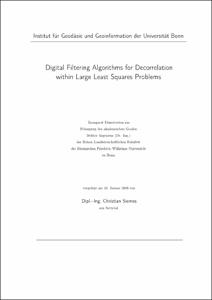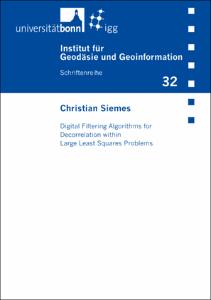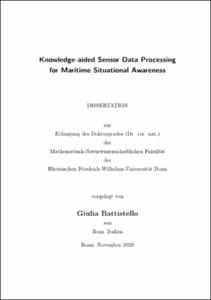Siemes, Christian: Digital Filtering Algorithms for Decorrelation within Large Least Squares Problems. - Bonn, 2008. - Dissertation, Rheinische Friedrich-Wilhelms-Universität Bonn.
Online-Ausgabe in bonndoc: https://nbn-resolving.org/urn:nbn:de:hbz:5N-13749
Online-Ausgabe in bonndoc: https://nbn-resolving.org/urn:nbn:de:hbz:5N-13749
@phdthesis{handle:20.500.11811/3244,
urn: https://nbn-resolving.org/urn:nbn:de:hbz:5N-13749,
author = {{Christian Siemes}},
title = {Digital Filtering Algorithms for Decorrelation within Large Least Squares Problems},
school = {Rheinische Friedrich-Wilhelms-Universität Bonn},
year = 2008,
volume = 32,
note = {The GOCE (Gravity Field and steady-state Ocean Circulation Explorer) mission is dedicated to the determination of the Earth's gravity field. During the mission period of at least one year the GOCE satellite will collect approximately 100 million highly correlated observations. The gravity field will be described in terms of approximately 70,000 spherical harmonic coefficients. This leads to a least squares adjustment, in which the design matrix occupies 51 terabytes while the covariance matrix of the observations requires 72,760 terabytes of memory. The very large design matrix is typically computed in parallel using supercomputers like the JUMP (Juelich Multi Processor) supercomputer in Jülich, Germany. However, such a brute force approach does not work for the covariance matrix. Here, we have to exploit certain features of the observations, e.g. that the observations can be interpreted as a stationary time series. This allows for a very sparse representation of the covariance matrix by digital filters.
This thesis is concerned with the use of digital filters for decorrelation within large least squares problems. First, it is analyzed, which conditions the observations must meet, such that digital filters can be used to represent their covariance matrix. After that, different filter implementations are introduced and compared with each other, especially with respect to the calculation time of filtering. This is of special concern, as for many applications the very large design matrix has to be filtered at least once. One special problem arising by the use of digital filters is the so-called warm-up effect. For the first time, methods are developed in this thesis for determining the length of the effect and for avoiding this effect. Next, a new algorithm is developed to deal with the problem of short data gaps within the observation time series. Finally, it is investigated which filter methods are best adopted for the application scenario GOCE, and several numerical simulations are performed.},
url = {https://hdl.handle.net/20.500.11811/3244}
}
urn: https://nbn-resolving.org/urn:nbn:de:hbz:5N-13749,
author = {{Christian Siemes}},
title = {Digital Filtering Algorithms for Decorrelation within Large Least Squares Problems},
school = {Rheinische Friedrich-Wilhelms-Universität Bonn},
year = 2008,
volume = 32,
note = {The GOCE (Gravity Field and steady-state Ocean Circulation Explorer) mission is dedicated to the determination of the Earth's gravity field. During the mission period of at least one year the GOCE satellite will collect approximately 100 million highly correlated observations. The gravity field will be described in terms of approximately 70,000 spherical harmonic coefficients. This leads to a least squares adjustment, in which the design matrix occupies 51 terabytes while the covariance matrix of the observations requires 72,760 terabytes of memory. The very large design matrix is typically computed in parallel using supercomputers like the JUMP (Juelich Multi Processor) supercomputer in Jülich, Germany. However, such a brute force approach does not work for the covariance matrix. Here, we have to exploit certain features of the observations, e.g. that the observations can be interpreted as a stationary time series. This allows for a very sparse representation of the covariance matrix by digital filters.
This thesis is concerned with the use of digital filters for decorrelation within large least squares problems. First, it is analyzed, which conditions the observations must meet, such that digital filters can be used to represent their covariance matrix. After that, different filter implementations are introduced and compared with each other, especially with respect to the calculation time of filtering. This is of special concern, as for many applications the very large design matrix has to be filtered at least once. One special problem arising by the use of digital filters is the so-called warm-up effect. For the first time, methods are developed in this thesis for determining the length of the effect and for avoiding this effect. Next, a new algorithm is developed to deal with the problem of short data gaps within the observation time series. Finally, it is investigated which filter methods are best adopted for the application scenario GOCE, and several numerical simulations are performed.},
url = {https://hdl.handle.net/20.500.11811/3244}
}









